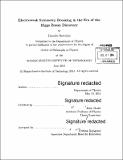Electroweak symmetry breaking in the era of the Higgs boson discovery
Author(s)
Bertolini, Daniele, Ph. D. Massachusetts Institute of Technology
DownloadFull printable version (11.29Mb)
Other Contributors
Massachusetts Institute of Technology. Department of Physics.
Advisor
Jesse Thaler.
Terms of use
Metadata
Show full item recordAbstract
In this thesis we study possible deviations from the electroweak symmetry breaking mechanism as predicted by the Standard Model (SM), and we introduce a new framework to analyze hadronic final states at colliders. In the first part, we begin by considering supersymmetric extensions of the SM and by studying the connection between electroweak symmetry breaking and supersymmetry breaking. Contrary to the common lore, we show that a visible dynamics in the Higgs sector can contribute to supersymmetry breaking, as long as soft masses receive contributions also from one or more hidden sectors. A striking feature is the presence of a light pseudo-goldstino in the spectrum. We study potential collider signatures of visible supersymmetry breaking in Higgs and neutralino decays. Then, we move to a study of the Higgs data collected at the Large Hadron Collider (LHC). By using both measurements of the Higgs boson couplings, and limits on Higgs-like states at higher masses, we investigate whether the data support the possibility that the SM Higgs is mixed with another scalar. We consider fits to simplified models and we find that mixing angles with sin 2 6 > 0.2 are disfavored at 95% CL over a scalar mass range 200 - 1000 GeV. In the second part, we propose a new way to define inclusive jet (and subject) based observables at colliders. We introduce a new class of event shapes that characterize the jet-like structure of the event by using only information in the neighborhood of each particle. We show that conventional jet-based observables such as jet multiplicity, summed scalar transverse momentum, and missing transverse momentum can be recovered within this approach. We show that in this framework trimming can be recast as a particle weight assignment, without explicit jet identification. Finally, we comment on potential applications of the method both at trigger and analysis level.
Description
Thesis: Ph. D., Massachusetts Institute of Technology, Department of Physics, 2014. 166 Cataloged from PDF version of thesis. Includes bibliographical references (pages 115-125).
Date issued
2014Department
Massachusetts Institute of Technology. Department of PhysicsPublisher
Massachusetts Institute of Technology
Keywords
Physics.